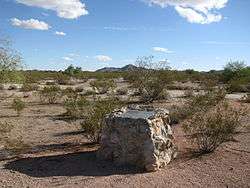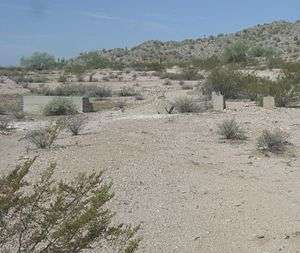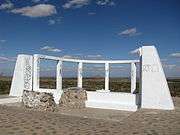Gila River War Relocation Center
| Gila River Internment Camp | |
|---|---|
|
School children participating in the Harvest Festival Parade | |
 Location in Pinal County and the state of Arizona | |
 Gila River Internment Camp Location in the United States | |
| Coordinates: 33°03′54.3″N 111°49′49.9″W / 33.065083°N 111.830528°WCoordinates: 33°03′54.3″N 111°49′49.9″W / 33.065083°N 111.830528°W | |
| Country | United States |
| County | Pinal |
| Area | |
| • Total | 2.4 sq mi (6.1 km2) |
| • Land | 2.4 sq mi (6.2 km2) |
| Time zone | MST (no DST) (UTC-7) |
The Gila River War Relocation Center was an internment camp built by the War Relocation Authority (WRA) for internment of Japanese Americans during the Second World War. It was located about 30 miles (48.3 km) southeast of Phoenix, Arizona.
History
The relocation center was located on the Gila River Indian Reservation, near an irrigated agricultural center. It comprised two separate camps, named 'Canal' and 'Butte'. Construction began on May 1, 1942, over the strong objections of the reservation's American Indian government. The official opening took place less than two months later, on July 20. Canal Camp closed on September 28, 1945. Butte Camp was shut down on November 10, 1945 and the Gila River Internment Center was officially closed on November 16, 1945.
Gila River received internees from California (Fresno, Sacramento, and Los Angeles). In addition, it took in 2,000 people from the Jerome War Relocation Center in Arkansas when that facility closed in 1944. It became Arizona's fourth-largest city, with a peak population of 13,348.
Some of the intended internees died en route to Gila River or shortly after arrival in the harsh desert environment. One of these was the mother of Iva Toguri, the American woman of Japanese descent who was later condemned as "Tokyo Rose" and convicted of treason due to perjured testimony.

Gila River was considered one of the least oppressive camps of its kind. It had only a single watchtower, and its fences were among the very few that lacked barbed wire. The administrators of the camps seemed to care for the evacuees, and allowed them access to the amenities of Phoenix, and recreational activities such as sports and arts. Butte camp contained a 6,000-seat baseball field, designed by Kenichi Zenimura, a professional baseball player, and considered to be the best in the WRA system. Internees also built a theater for plays and films, built playgrounds, and planted trees. Gila River had a communal medical facility at Butte Hospital. Canal Camp had 404 buildings with 232 barracks and 24 separate schoolhouses. Butte Camp contained 821 buildings with 627 residential barracks. These barracks were made of wood and fireproof shingles that blocked out the desert heat. Each barrack was made to house four single families in separate apartments. Unfortunately, the camp exceeded its capacity: it was designed for 10,000 residents, but held over 13,000. Because of this some families resorted to living in the mess hall or recreation buildings and used blankets as makeshift walls. Water shortages also plagued the camp, and poisonous rattlesnakes and scorpions kept Butte Hospital extremely busy.
As the land for the camp sites is owned by the Gila River Indian Tribe and is considered sacred by them, public access to the sites is currently restricted. Although all the main structures are long gone, some artifacts, such as the road grid, concrete slab foundations, manholes, cisterns, several rock alignments and dozens of small ponds, remain today.
On December 21, 2006, President Bush signed H.R. 1492 into law guaranteeing $38,000,000 in federal money to restore the Gila River relocation center along with nine other former Japanese internment camps. "H.R. 1492".
Notable Gila River internees

- George Aratani (1917–2013), an entrepreneur and philanthropist
- Harry K. Fukuhara (1920–2015), inducted in the United States Military Intelligence Hall of Fame.
- Evelyn Nakano Glenn, a professor of Gender & Women Studies and of Ethnic Studies at the University of California, Berkeley and founding director of the Center for Race and Gender (CRG). Also interned at Heart Mountain.
- George Hoshida (1907–1985), a Japanese American artist who made drawings of his experience during his incarceration in three internment camps. Also interned at Jerome
- Dale Ishimoto (1923–2004), an American actor
- Yuriko Kikuchi (born 1920), an American dancer and choreographer.
- Jay Kazuo Kochi (1927–2008), a physical organic chemist
- Tomoko Miho (born 1931), a designer and recipient of the 1993 Aiga Medal.
- Noriyuki "Pat" Morita (1932–2005), an American actor known for roles on Happy Days and in the Karate Kid movies. Also interned at Tule Lake.
- George I. Nakamura, a lieutenant in the United States Army during World War II, and recipient of the Bronze Star.
- Ken and Miye Ota (born 1923 and 1918 respectively), a married couple known for teaching martial arts, ballroom dancing, and social graces at their cultural school.
- Kazuo Otani (1918–1944), a United States Army soldier and a recipient of the Medal of Honor.
- Reiko Sato (1931–1981), an American dancer and actress.
- Miiko Taka (born 1925), an American actress.
- Nao Takasugi (1922–2009), an American politician.
- James Takemori (1926–2015), an American judoka and World War II veteran.
- Paul Terasaki (1929–2016), organ transplant scientist and Professor Emeritus of Surgery at UCLA School of Medicine
- Michi Nishiura Weglyn (1926–1999), author of Years of Infamy: The Untold Story of America’s Concentration Camps.
- Kenichi Zenimura (1900–1968), a baseball player and manager.
Gallery
| Historic Gila River War Relocation Center | ||||||||||||||
|---|---|---|---|---|---|---|---|---|---|---|---|---|---|---|
|
See also
- Japanese American Internment
- War Relocation Authority
- World War II
- Densho: The Japanese American Legacy Project
- Other camps:
External links
- War Relocation Camps in Arizona 1942-1946
- Photo of Eleanor Roosevelt visiting the camp
- Gila River Relocation Center
- NPS's Gila River page
- Leong, Karen J. "Densho Encyclopedia: Gila River". encyclopedia.densho.org. Densho. Retrieved 2016-07-12.
- A Diamond in the Desert written by Kathryn Fitzmaurice
- Wakida, Patricia. "Densho Encyclopedia: Gila News-Courier (camp newspaper)". encyclopedia.densho.org. Densho. Retrieved 2016-07-12.


